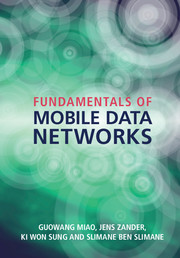Book contents
- Frontmatter
- Contents
- Preface
- Acronyms
- Notations
- 1 Introduction
- 2 Wireless network models
- 3 Medium access control
- 4 Scheduling
- 5 Principles of cellular systems
- 6 Transmitter power control
- 7 Interference management
- 8 Association and handover
- 9 Energy-efficient design
- 10 Long term evolution
- 11 Wireless infrastructure economics
- About the authors
- Index
- References
10 - Long term evolution
Published online by Cambridge University Press: 05 March 2016
- Frontmatter
- Contents
- Preface
- Acronyms
- Notations
- 1 Introduction
- 2 Wireless network models
- 3 Medium access control
- 4 Scheduling
- 5 Principles of cellular systems
- 6 Transmitter power control
- 7 Interference management
- 8 Association and handover
- 9 Energy-efficient design
- 10 Long term evolution
- 11 Wireless infrastructure economics
- About the authors
- Index
- References
Summary
3GPP Long Term Evolution (LTE) represents the fourth generation of cellular technologies. It is designed to support high-speed multimedia unicast and broadcast services. The LTE physical layer is very efficient in handling both data and control signaling and employs advanced technologies like orthogonal frequency division multiplexing (OFDM) and multiple input multiple output (MIMO). In the downlink, LTE uses orthogonal frequency division multiple access (OFDMA) and in the uplink, single carrier-frequency division multiple access (SC-FDMA). LTE allows flexible resource allocation on a subcarrier-by-subcarrier basis for a specified number of OFDM symbols, which significantly increases spectral efficiency. In addition, LTE implements advanced interference management schemes to boost overall network capacity. Both frequency division duplexing (FDD) and time division duplexing (TDD) are supported in LTE. This chapter will focus on LTE FDD systems and the corresponding radio resource management in the physical layer. The goal of this chapter is not to exhaust all tutorial information on LTE, but rather to illustrate the combination of underlying theoretical principles introduced in the previous chapters of this book and the specific system design constraints in LTE.
Physical layer for downlink
The LTE downlink transmission multiplexes both UE (user equipment) data and control signaling. There are three dimensions in the downlink transmission resources: time, frequency and space. The time–frequency resources are divided using orthogonal frequency division multiple access (OFDMA) and the resources in the spatial dimension are managed by multiple antenna transmission and reception techniques. Below we will give a brief introduction to the key technologies in forming the transmitted downlink signals and the resource structure in LTE.
Orthogonal frequency division multiplexing
The main advantage of using OFDM is to increase robustness against frequency-selective fading and narrowband interference. OFDM is a modulation scheme that fits high-speed communications in delay-dispersive environments as it converts a high-data-rate stream into many low-rate streams. These low-rate streams are transmitted over parallel, orthogonal, narrowband channels that can be easily equalized. OFDM was first invented in the mid-1960s [R. W. Chang, 1966, 1970]. In 1985, Cimini was the first to describe the use of OFDM for wireless communications [L. J. Cimini, 1985]. In this section we give a brief introduction to the basic properties and advantages of OFDM.
As shown in Figure 3.6, the bit stream is first converted to K parallel streams using a serial to parallel (S/P) converter.
Information
- Type
- Chapter
- Information
- Fundamentals of Mobile Data Networks , pp. 258 - 281Publisher: Cambridge University PressPrint publication year: 2016
